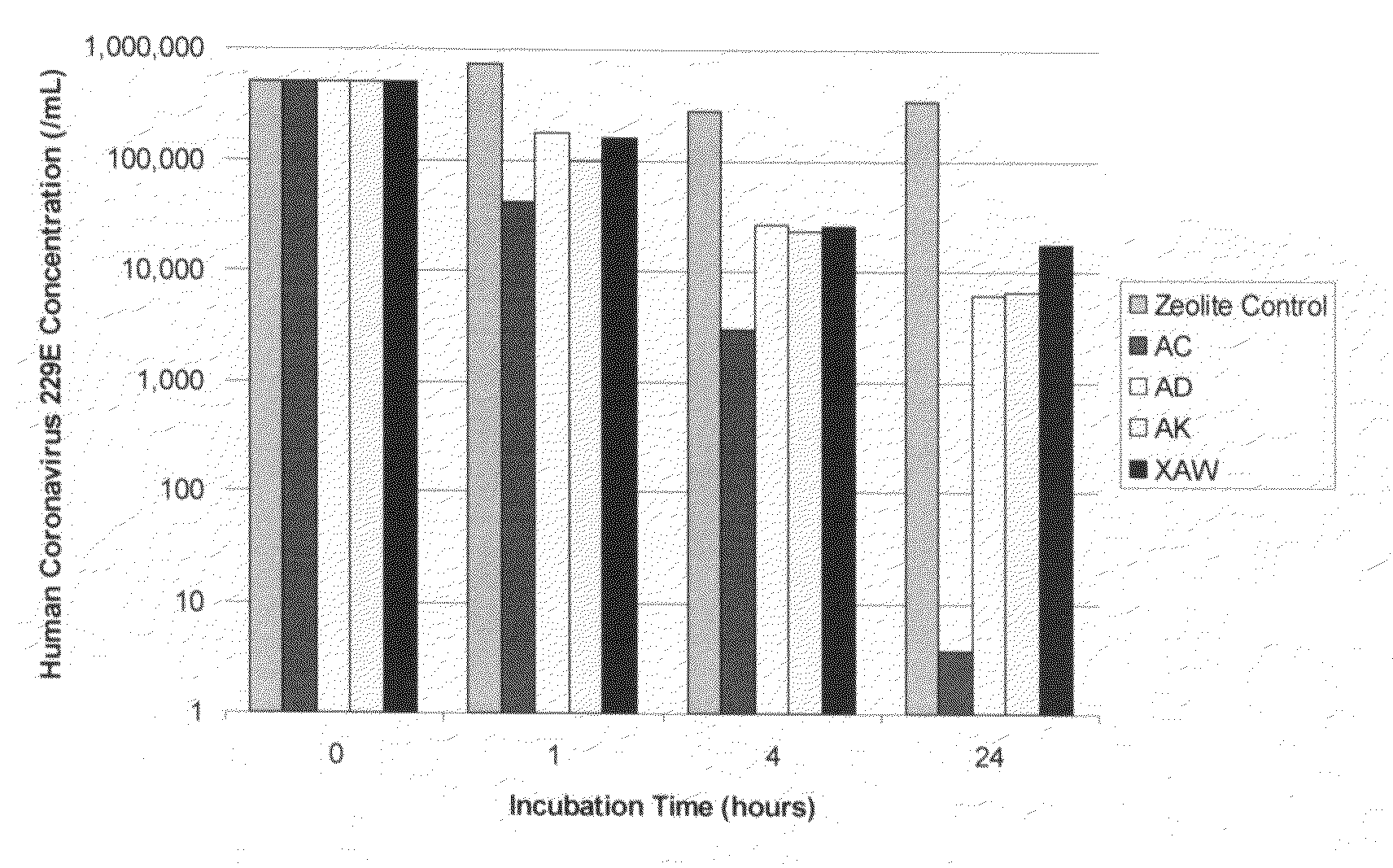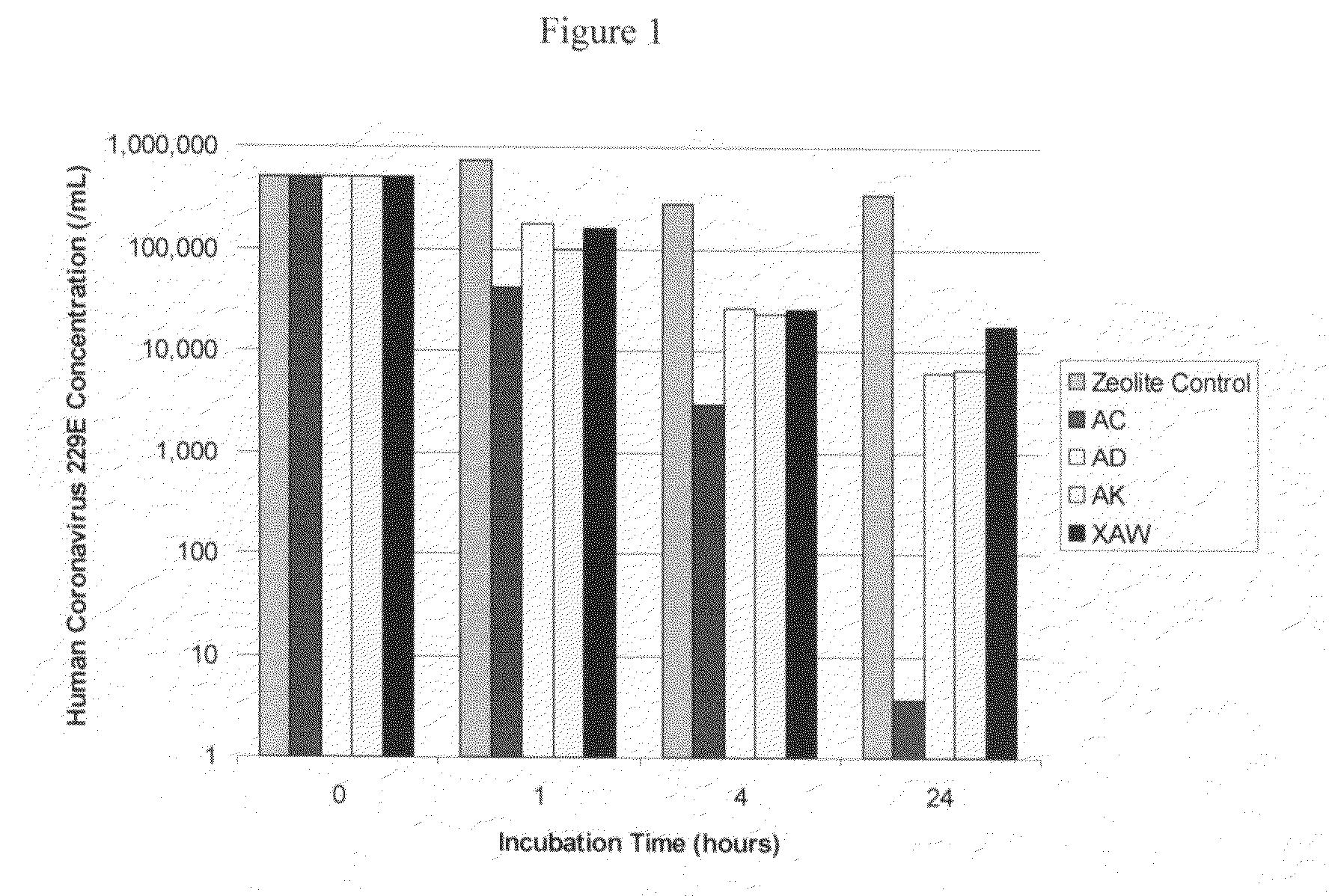Antiviral Methods
a technology of antiviral methods and antiviral agents, which is applied in the field of antiviral methods, can solve the problems of not being able to demonstrate or suggest the possibility of antiviral applications, not being able to demonstrate or suggest the use of antiviral agents in attacking viruses, and not being able to mention specific viruses
- Summary
- Abstract
- Description
- Claims
- Application Information
AI Technical Summary
Benefits of technology
Problems solved by technology
Method used
Image
Examples
example 1
[0060]A first set of viral testing was conducted on the human coronavirus strain 229E and the feline infectious peritonitis virus (FIPV), both obtained from American Type Culture Collection of Rockville, Md. (ATCC #VR-740 and ATCC #VR-990, respectively). These viruses are often used as surrogates for SARS coronavirus (ScoV). In this set of experiments, flasks containing suspensions of five different zeolite materials were inoculated with the aforementioned viruses, the original titer being 5.0×105 TCID50 / ml for the human coronavirus and 5.6×103 TCID50 / ml for the FIPV virus. All five zeolite materials were type A zeolites, the first, Zeolite A, was unmodified. Four modified zeolites were prepared by ion-exchange to incorporate various metal ions as follows; Zeolite B—3.5 wt % silver and 6.5 wt % copper, Zeolite C—20 wt % silver, Zeolite D—5.0 wt % silver and 14% zinc, and Zeolite E—a combination of 80% zinc oxide and 20% zeolite having 0.6 wt % silver and 14 wt % zinc. All zeolites w...
example 2
[0062]A second set of viral testing was conducted on the human coronavirus strain 229E and the feline calicivirus strain F-9, both obtained from American Type Culture Collection of Rockville, Md. (ATCC #VR-990 and ATCC #VR-782, respectively). Feline calicivirus, an accepted surrogate for the human NoV pathogenic virus, is an enveloped virus, a form of virus that is typically more resistant to environmental conditions and the action of antimicrobial / antibiotic agents. In this set of experiments, Zeolite B from Example 1 was compounded into polyethylene, at two different loadings, 5 wt % and 10 wt %, and coupons molded from the compounded materials. Each polyethylene coupon was inoculated using a sterile glass rod with 0.1 ml of diluted virus: the original titer of each virus being 4.05×105 TCID50 for human coronavirus and 5.0×106 PFU for feline calicivirus. The coupons were placed in humidity chambers (˜95% relative humidity) at room temperature (23° C.). Each coupon was sampled usin...
example 3
[0064]A further set of experiments was conducted on the H5N1 bird influenza virus obtained from the Ministry of Agriculture in China using two different solutions, one containing a silver / copper zeolite, Zeolite B from Example 1, and the other containing another type A zeolite, Zeolite F, containing 3.5 wt % silver and 14 wt % zinc. In this experiment, 10-day old SPF chick embryos obtained from the China Agricultural Scientific Academy were inoculated with a solution that contained both the H5N1 virus and four different concentrations (10, 20, 100 and 200 mg / ml) of each of the two different zeolites in sterilized normal saline. Initially, two control studies were performed, one inoculating embryos with a series of 0.1 ml solutions of each of different concentrations of the zeolite solutions and the other inoculating the embryos with 0.1 ml solutions of a 10-times series dilution of the H5N1 virus. According to the first control study, none of the zeolite solutions were found to caus...
PUM
 Login to View More
Login to View More Abstract
Description
Claims
Application Information
 Login to View More
Login to View More - R&D
- Intellectual Property
- Life Sciences
- Materials
- Tech Scout
- Unparalleled Data Quality
- Higher Quality Content
- 60% Fewer Hallucinations
Browse by: Latest US Patents, China's latest patents, Technical Efficacy Thesaurus, Application Domain, Technology Topic, Popular Technical Reports.
© 2025 PatSnap. All rights reserved.Legal|Privacy policy|Modern Slavery Act Transparency Statement|Sitemap|About US| Contact US: help@patsnap.com


